My Relationship with Mongolia
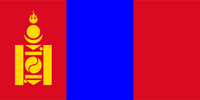 From 2003 to 2018, I have been involved with Mongolia because of my work. Please see "Travelogue-Mongolia"
on this site for the circumstances. I visited many times, but I couldn't get enough time and I had no chance to meet with amateur radio people. In September 2008,
I was invited to visit the 50th anniversary event of the Mongolian State University of Agriculture, which I was interacting with. I found that I had a relatively
free time at this time, so I searched for the homepage of Mongolian Amateur Radio Society-Монголын радио сонир хогчдын холбоо. Unfortunately, the home page is only in
Mongolian, so I'm not sure but I searched QRZ.com for the email address of JT1BV, the call sign I happened to find in the site, and contacted him by e-mail. I received
an immediate reply, but unfortunately he was staying in the US, and instead he introduced me to JT1CD and he arranged for me.
From 2003 to 2018, I have been involved with Mongolia because of my work. Please see "Travelogue-Mongolia"
on this site for the circumstances. I visited many times, but I couldn't get enough time and I had no chance to meet with amateur radio people. In September 2008,
I was invited to visit the 50th anniversary event of the Mongolian State University of Agriculture, which I was interacting with. I found that I had a relatively
free time at this time, so I searched for the homepage of Mongolian Amateur Radio Society-Монголын радио сонир хогчдын холбоо. Unfortunately, the home page is only in
Mongolian, so I'm not sure but I searched QRZ.com for the email address of JT1BV, the call sign I happened to find in the site, and contacted him by e-mail. I received
an immediate reply, but unfortunately he was staying in the US, and instead he introduced me to JT1CD and he arranged for me.
About Mongolian Amateur Radio
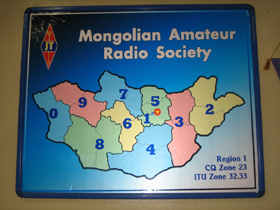 In Mongolia, there are 10 call areas as shown in the photo to the right. This country is relatively close to Japan, so if you hear the signal from there, you can definitely
communicate. However, until now, I have communicated with only JT1. It may be unavoidable that 1 area is the capital Ulaanbaatar area where more than 50% of the population is
concentrated. There are only about 10 amateur radio stations in Ulaanbaatar, and there are only a few mobile stations in other regions.
In Mongolia, there are 10 call areas as shown in the photo to the right. This country is relatively close to Japan, so if you hear the signal from there, you can definitely
communicate. However, until now, I have communicated with only JT1. It may be unavoidable that 1 area is the capital Ulaanbaatar area where more than 50% of the population is
concentrated. There are only about 10 amateur radio stations in Ulaanbaatar, and there are only a few mobile stations in other regions.
Vsit Mongolian Amateur Radio Society
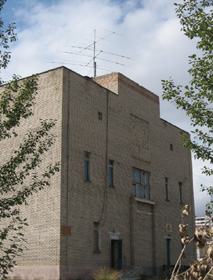 As we were scheduled, JT1CD Khos picked me up at the hotel on the 14th September. The association is located in a free-renting room on the first floor of the building that
originally used by Mongolian Telecom. Club station JT1KAA is installed there as well as QSL Bureau. Eight members were welcomed to the association and toasted horse milk wine
"Airag айраг" and its distilled spirit, "Shimiin Arkhi шимийн архи", according to the Mongolian tradition. By the way, Arkhi was home brewed.
As we were scheduled, JT1CD Khos picked me up at the hotel on the 14th September. The association is located in a free-renting room on the first floor of the building that
originally used by Mongolian Telecom. Club station JT1KAA is installed there as well as QSL Bureau. Eight members were welcomed to the association and toasted horse milk wine
"Airag айраг" and its distilled spirit, "Shimiin Arkhi шимийн архи", according to the Mongolian tradition. By the way, Arkhi was home brewed.
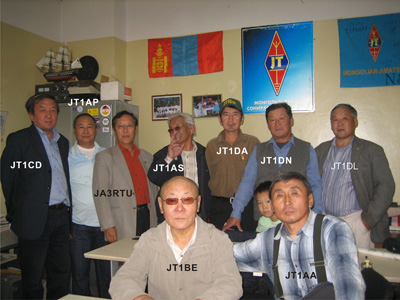 The radio station is a small configuration consisting of Kenwood TS-50S and TS-440, and a home brewed linear amplifier. The linear amplifier was made firmly using the Russian
ceramic triode GU-43. Antennas were 3 elements 14-21-28 triband Yagi-Uda antenna and 6 elements Yagi-Uda antenna for 50 MHz installed on the roof top of the building.
The radio station is a small configuration consisting of Kenwood TS-50S and TS-440, and a home brewed linear amplifier. The linear amplifier was made firmly using the Russian
ceramic triode GU-43. Antennas were 3 elements 14-21-28 triband Yagi-Uda antenna and 6 elements Yagi-Uda antenna for 50 MHz installed on the roof top of the building.
The WAEDC contest was held on the day, but I tried to operate JT1KAA as a visitor on 14 MHz band. Unfortunately the propagation condition was not good and I could not communicate
with any station.
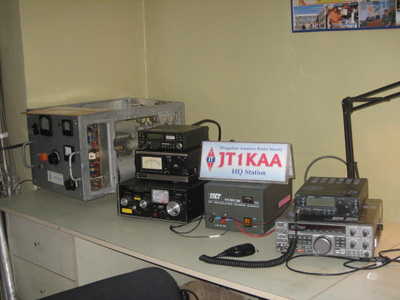
|
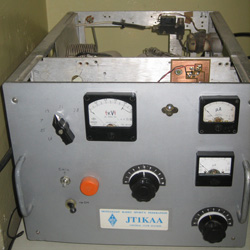
|
Since Mongolian belongs to the same language group as Japanese, everyone was not very good at English speaking, so it was not very easy to listen to various stories. However, I could have a very good time by saying that we have the same hobby. Finally, We took a commemorative photo at the entrance of the building with the other member who came after and the son of JT1DN. I contributed an article of this visit to February 2009 issue of CQ Ham radio.
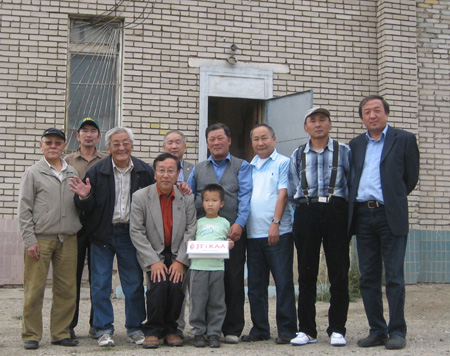 |
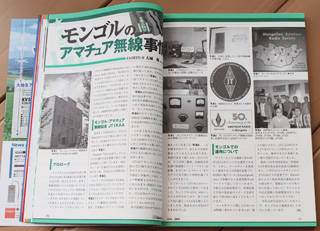
|
